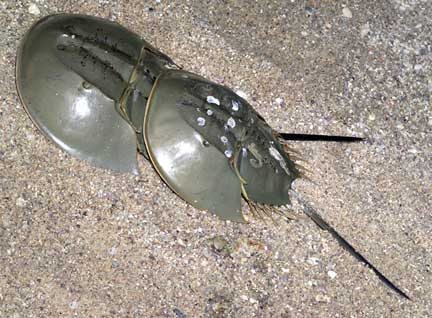
The moon crab Matuta lunaris has legs which are flattened into paddles. They use their legs to dig themselves efficiently into the sand.
Next, someone else spotted a leaf moving amidst a clump of immobile leaves. Curious, she flipped it over to find a leaf porter crab hiding underneath! It did not seem to appreciate its sudden change in spatial orientation, however, and quickly flipped itself back under the leaf using its long spindly legs. We quickly placed it back into the pool of water, where it resumed floating around, looking like just another leaf.

Neodorippe callida, the leaf porter crab.
The most exciting find of the day was a pair of coastal horseshoe crabs, another rarely-seen animal in our Southern Shores. Horseshoe crabs are fascinating creatures, which I find really awe-inspiring to observe. They are known as living fossils because they have been around for a really long time (even before the dinosaurs!), and actually are more closely related to spiders than the true crabs of today. This is obvious when you look at their body plan, which is kind of alien to anything else I've ever seen. For example, they have pairs of walking legs sticking out at both sides underneath their helmet-like shells. These legs are used to grind up food as they walk, after which the food is passed into the mouth, located between the second pair of legs. The coolest fact about the horseshoe crab (for me) is that such an ancient creature has such an important and unique use in today's advanced medical industry. The blood of a horseshoe crab contains a medically important substance that is vital in testing iv drugs and medical equipment for bacterial contaminations, without which there would be no easy way of determining if something is sterile. For more information about these truly amazing animals, see Ria's horseshoe crab factsheet.

The pair of horseshoe crabs (Tachypleus gigas), one of 2 species in Singapore. They were spotted behind a pile of boulders on Labrador - the female was trying to crawl out over it with the male firmly attached on her back with his claspers, and may have gotten stranded there as the tide went out.

Here they are again, after we carried them out to the sand. The male is still tightly hanging on, on the back of the female. Horseshoe crabs are harmless, their tails are used for steering and helping them right themselves.

The alien-looking underside of a horseshoe crab - the mouth is located between the legs (see the hairy area?).
Many thanks to Ria for the photographs!